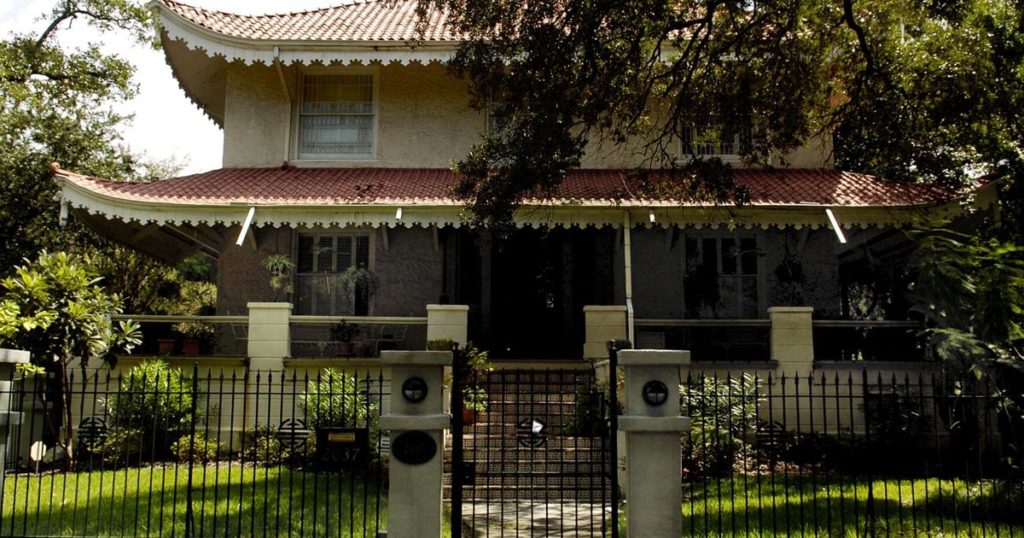[ad_1]
He didn’t build it. He never visited it or even wrote about it.
Yet, when it comes to the distinctly Japanese-inspired Pagoda House at 2037 Napoleon Ave., local lore — which has never depended on such inconveniences as hard evidence — persists in the belief that none other than Lafcadio Hearn was the chief inspiration behind it.
Part of that is because New Orleanians will never cease to love the silver-tongued, Greek-born scribe, who came to New Orleans via Cincinnati only to fall head-over-heels in love with the place.
In his decade here, from 1877 to 1887, Hearn wrote a lot about the Crescent City for local newspapers, as well as for national publications including Harper’s and Scribner’s.
Spreading the mystique
Those latter gigs are credited with popularizing the city’s mystique among a national audience, but if there’s one thing for which he’s remembered in New Orleans, it is his now-famous declaration that “it is better to live here in sackcloth and ashes than to own the whole state of Ohio.”
(If you want to earn the eternal affection of the city, just write something like that.)
But the question remains: What exactly did Hearn have to do with the Pagoda House?
Well, as it turns out, Hearn’s time in New Orleans overlapped with the 1884 World Cotton Centennial. It was there that he was reputedly introduced to Japanese culture. A decade after falling head-over-heels in love with New Orleans, he fell even more head-over-heels in love with Japan.
Moving to Japan
In fact, in 1890, shortly after leaving New Orleans, Hearn moved to Japan, where he married, assumed the name Koizumi Yakumo and spent the rest of his life.
In those years, however, he maintained an epistolary relationship with Raoul Vallon, a well-to-do insurance agent who was active in New Orleans social circles, including as a member of the Rex organization.
As part of their regular correspondence, Hearn would send along illustrations and descriptions of Japanese buildings, said one of Vallon’s grandchildren, Henriette Vallon Monrose, in a 2004 interview with The Times-Picayune.
“Hearn told my grandfather, ‘I am showing you several plans that would be wonderful for the New Orleans climate,’” Monrose said. “Breezes go in and out and air rises through the belvedere.”
In the days before air-conditioning, that was no small thing.
Under the influence
Soon after, Vallon hired architect Frank P. Graveley — whose other work includes the Queen & Crescent building at 344 Camp St. — to design for him a new family home at 2037 Napoleon Ave.
With the guidance of Vallon, and, apparently, the illustrations of Hearn, Graveley designed a unique four-bedroom structure, built of cypress on a ground-level basement.
A porch encircles the second-story main living area. More living space is on the floor above, with the whole thing crowned by a small, square, breeze-accommodating belvedere.
The Japanese influence in the building is unmistakable. Corner of all three levels of its red-tiled roof are gently upturned, providing its most conspicuous Eastern feature. The belvedere on the top lends the whole thing a triangular, almost-temple-like profile.
More Eastern details
The wide windows were designed to mimic paper and bamboo windows. The heavy double doors leading inside from the front porch are adorned with the stained-glass likenesses of a pot of bamboo and the rising sun.
Similarly Asian-inspired adornments were installed throughout, including holly-and-berry molding, as well as carved figures on the stairway that are said to represent good fortune.
The house was completed in 1904 at a cost of $15,000, the equivalent of more than $450,000 in 2022, according to the Bureau of Labor Statistics.
The Vallon family continued to live in it until 1925. Since then it’s changed hands a few times. Over the years, additional Eastern touches were added to enhance the pagoda effect.
Neither here nor there
Standing out amid the Greek Revival and Italianate mansions typically found along Uptown’s tonier streets, the so-called Pagoda House is certainly a striking homage to Japanese culture. That being said, it doesn’t quite capture the culture as faithfully as, say, Hearn’s writings on the mystique of New Orleans.
“Though it appears Asian-esque and foreign to Westerners, it also appears Western and foreign to people from East Asia,” historian Winston Ho wrote in 2019 in the Preservation Resource Center’s Preservation in Print.
Ho continued: “The Vallon Pagoda House is not a building you would ever see in Japan — perhaps not something you would see anywhere else in the world. It may be the only Japanese Creole house in existence.”
Coincidentally, Hearn died in 1904, the same year the Pagoda House was completed, so he never saw it.
But he’d likely be pleased that a building he influenced, no matter how indirectly, still stands, representing two of his favorite cities.
If nothing else, this much is for sure: It beats the heck out of sackcloth and ashes.
Sources: The Times-Picayune archives; Preservation in Print; Nippon.com
Know of a New Orleans building worth profiling in this column, or just curious about one? Contact Mike Scott at moviegoermike@gmail.com.
Some people call it the Valery Nicholas House. Others call it Casa Hinard or Casa Flinard. The plaque next to the door identifies it as the on…
It was the 1920s, and the French Quarter was positively sagging.
Today, it’s a largely overlooked parking lot, and not a very picturesque one, despite its prime location between the Mississippi River and the…
[ad_2]
Source link
